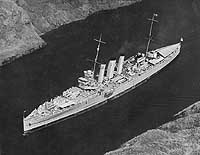
HMAS Australia, a 9850-ton heavy cruiser of the British Kent class, was built at Glasgow, Scotland. During the first decade of her active career, she mainly served in Australian home waters, but also cruised abroad on occasion. The cruiser was modernized in 1938-39, receiving much improved armor protection plus significant modifications to her forward superstructure, anti-aircraft gun battery, gunfire control systems and aircraft facilities.
After World War II broke out in Europe in September 1939, Australia operated in the Indian Ocean and South Atlantic, protecting shipping routes from the threat of German surface raiders. She went to the north Atlantic in mid-1940 and, in September of that year took part in the British Navy attack on Dakar, where she was hit by shells from the French cruisers Georges Leygues and Montcalm. Returning to Australia in 1941, she resumed her shipping protection work in the Indian Ocean.
In early 1942, with Japan now at war with the Allies, Australia was flagship of a small task force assigned to protect the south Pacific eastwards from Australia. In that capacity she engaged enemy aircraft in May, during the Battle of the Coral Sea. In August, she participated in the Guadalcanal Invasion. Thereafter, she mainly served as one of the heaviest ships involved in the fight for New Guinea, initially in a covering role. Beginning in late 1943, with the landings at Cape Gloucester, New Britain, Australia provided fire support and surface ship protection for the assault across northern New Guinea. On 8-9 June 1944, she was flagship of the task force that pursued Japanese destroyers off Biak.
Australia later participated in the Leyte invasion in October 1944 and the landings at Lingayen Gulf in January 1945. She was hit by a Japanese plane in the former operation, losing some twenty of her crew. No less than five Kamikazes struck her during the Lingayen operation, taking the lives of over forty crewmen, but she remained on her gunfire support station until no longer needed.
Subsequent repairs and alterations in 1945-46 reduced Australia's main battery from eight to six eight-inch guns, enhanced her anti-aircraft firepower and generally brought her up to date. She remained active in the post-war era, in her final years as a training ship, until she was paid off for the last time in August 1954. HMAS Australia was sold for scrapping in January 1955.
This page features, or provides links to, all our views of the Australian heavy cruiser Australia (1928-1955).
For more images of HMAS Australia, see:
| If you want higher resolution reproductions than the digital images presented here, see: "How to Obtain Photographic Reproductions." |
Click on the small photograph to prompt a larger view of the same image.
For more images of HMAS Australia, see:
| If you want higher resolution reproductions than the digital images presented here, see: "How to Obtain Photographic Reproductions." |
Page made 9 March 2002